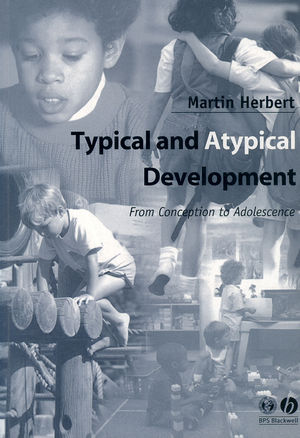Typical and Atypical Development: From Conception to AdolescenceISBN: 978-0-631-23465-4
Hardcover
448 pages
December 2002, Wiley-Blackwell
 This is a Print-on-Demand title. It will be printed specifically to fill your order. Please allow an additional 15-20 days delivery time. The book is not returnable.
|
||||||
Introduction:.
From Childhood to Adolescence.
Parenthood.
Concepts of Normality and Abnormality.
Age- and Stage-Related Tasks.
Crises of Development.
The Developmental History.
Part I: Typical Development:.
Where the Journey Begins.
The Intrauterine Stages and Perinatal Period.
Introduction.
1. The First Steps:.
Conception: The Beginning of Life.
Genetic Variation and Influence.
The Genotype.
The Human Genome Project.
Similarities and Differences in Individuals and Groups.
Progress from Conception to Birth.
Summary of Prenatal Developments.
Unanswered Questions.
2. The Perinatal Period :.
Anticipation of the Birth.
Fads and Fashions.
The Birth: Labour and Delivery.
The Mother and Postnatal Infant Care.
Maternal Bonding Theory.
Bonding to the Unborn Baby.
The Competent Infant.
Parenting.
Siblings.
Environmental Influences.
Representational Models of the Infant.
Part II: Typical Development:.
Infancy.
Introduction.
The First Relationship.
The Development of Sociability.
Crying And Smiling as Social Communication.
The Nature of Attachment.
Internal Representations and Selfhood.
Development of Self--other Awareness.
3. Early Childhood: The Pre-School Stage:.
Infant Growth and Development.
Physical Development.
The Nervous System.
The Brain Growth Spurt.
The Brain and Communication.
Biological Basis of Personality.
Sleeping Patterns.
Feeding Behaviour.
4. Perceptual, Motor and Language Development:.
Perceptual Development.
Vision and Fine Movement.
Motor Development.
The Proactive Brain.
Speech and Language Development.
Part III: Typical Development:.
Adaptation and Learning.
Introduction.
Adjustment and Adaptation.
Cultural Influences.
The Family Environment.
Childcare Practices.
Maternal Privation and Deprivation.
The Father's Role.
Divorce.
Adoption.
Surrogate Parenting.
Learning Theory.
Models of Learning.
The Adaptive Role of Fear.
Generalized Anxiety.
5. Early Childhood: The Pre-School Stage: Socialization and Cognitive Development.
Socialization and Self-Control.
Learning and Identification: Social and Moral Awareness.
Social Cognition.
Social Compliance.
The Development of Aggressive Behaviour.
Sex-Role (Gender) Identity.
Socializing Tasks.
Cognitive Development.
Play.
Theory of Mind.
6. Middle and Late Childhood:The School-Going Child:.
Developing a New Individuality.
Rules and Values.
Expectations of Parents.
Social Skills and Friendships.
Exchange Theory.
Siblings: The Longest Lasting Relationship.
7. Adolescence: Leaving Childhood Behind:.
The Changes of Puberty.
The End of Childhood.
Adolescent Sexuality.
Identity and Self-Image.
The Ending of Puberty.
Part IV: Atypical Development: The Hazardous Route:.
Introduction.
Issues Of Assessment, Definition and Measurement.
The Journey Begins Again: Prenatal Influences.
Genetic Influences: Inherited Abnormalities.
Chromosomal Abnormalities.
Genetic Accidents.
Patterns of Genetic Transmission.
Prenatal, Antenatal and Neonatal Screening.
Behavioural Genetics.
Neuropsychological Causation.
8. The Perilous First Journey: The Inhospitable Environment:.
Maternal Stress and Inherited Abnormalities.
Biological Adversity.
Teratogens.
9. The Hazardous Perinatal Period: The Atypical Route:.
The Apgar Test.
Survival Repertoires.
Birth Complications.
Prematurity.
Birth Trauma.
Anoxia.
Parental Attachment to Atypical Infants.
10. Early Childhood: Atypical Physical, Sensory and Motor Development:.
Physical Disorders and Disabilities.
Congenital Physical Anomalies.
Abnormalities of Haemoglobin.
Impairments of Vision.
Impairments of Hearing.
Motor Impairments.
Impairments of Speech and Language.
Executive Functions of the Brain.
Neurological Damage.
Tics and Tourette's Syndrome.
Head Injuries.
11. The Pre-School Child: Atypical Behavior:.
The Authoritative Parent.
Socialization.
Assertive/Commanding Behaviour in Young Children.
Adverse Temperamental Attributes.
The ‘Difficult' Child.
Oppositional Defiant Disorder.
Developmental (Physical) Task Problems.
12. The School-Going Child: Atypical Behavior.
Educational Failure.
Insecurity Based Problems.
Reactive Attention Disorder.
Peer Group Problems.
Rejection.
Social Skills Problems.
Selective Mutism.
School Refusal.
Attention Deficit and Hyperactivity at School.
Severe (Profound) Learning Disabilities.
Specific Learning Disabilities.
Dyslexia.
Part V: Atypical Development: Mental Health and Mental Illness:.
Introduction.
Positive Mental Health.
Mental Illness.
13. Adolescence: Unsocial and Antisocial Behavior:.
Prejudice.
Risky Sexual Activity.
Drug Use and Abuse.
Antisocial Behaviour: Conduct Disorders.
Attention Deficit Hyperactivity Disorder.
Bullying.
Delinquency.
Personality Disorder.
Moral Development.
14. Psychological and Psychiatric Disorders:.
Mental Health Problems.
Anxiety States.
Phobic Anxiety.
Panic Attacks.
Agoraphobia.
Obsessive–Compulsive Disorder.
Depression (Affective Disorder).
Schizophrenia.
Part VI: Atypical Development: Children with Special Needs:.
Introduction.
Defining Need.
Developmental Disability.
The Child Who is Ill.
Child Protection.
15. Pervasive Developmental Difficulties: Early to Late Childhood and Adolescence.
Intellectual (Learning) Disability.
Classification of Intellectual Impairment.
Pervasive Developmental Disorders.
The Autistic Continuum.
Asperger's Disorder.
Anorexia Nervosa.
16. When a Child is Ill:.
Chronic Illness.
Implications of Acute and Chronic Illness.
Serious Illness (Hospitalization).
Development of The Concept of Death.
Ethical Issues.
17. Child Abuse and Maltreatment:.
Physical Abuse.
Emotional Abuse.
Child Sexual Abuse.
Epilogue.
Appendix I: False and True Beliefs.
Appendix II: Measurement of Intelligence.
References and Bibliography.
Index.



